The art in the early Renaissance started off with a new outlook on art. Although inspired by the Greeks and Romans, the early art in the Renaissance had much more of a naturalistic idea about it, compared to Greek and Roman art. An example of this is a painting from 1447 by Piero della Francesca. The man in this painting looks a little odd, because part of his nose is cut off. He wanted to be painted how he really looked: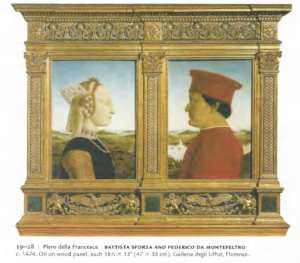 (pg643) People would start having artist paint their portrait as they were in real life, rather than making a unrealistic and perfect image of the person. Also during the Renaissance a lot of the art was influence by, not only Greek and Roman art, but mainly by Christianity. Luca Della Robbia also started experimenting and came up with the idea of waterproofing glaze for pots and making molds for ceramics in order to make many replicas (pg634 in the reading). Before the Renaissance, tempera was used quite often for the medium for painting. During the Renaissance artist , such as Venetians started using oil paints(pg635 in the reading). They also started experimenting with linear perspective and two point perspective. An example of two point perspective being used is this painting by Fra Angelico:
(pg643) People would start having artist paint their portrait as they were in real life, rather than making a unrealistic and perfect image of the person. Also during the Renaissance a lot of the art was influence by, not only Greek and Roman art, but mainly by Christianity. Luca Della Robbia also started experimenting and came up with the idea of waterproofing glaze for pots and making molds for ceramics in order to make many replicas (pg634 in the reading). Before the Renaissance, tempera was used quite often for the medium for painting. During the Renaissance artist , such as Venetians started using oil paints(pg635 in the reading). They also started experimenting with linear perspective and two point perspective. An example of two point perspective being used is this painting by Fra Angelico: 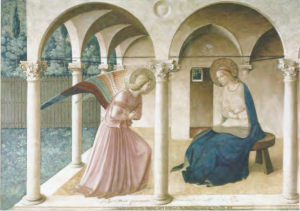 (pg 639 in the reading). A person could recognize this is in two point perspective by noticing that the columns have visible corners. In the second half of the 15th century this new form of art started to spread around, although they were all stylized a bit differently according to each artist style. One of these places to embrace the new Renaissance art was the Urbino Palace. One of the new creations of the Renaissance art was the trompe l’oeil effect. It was used as an expression in intarsia which is a wood inlay sort of decoration. They would make intricate scenes that would surround the walls. They would contain the new idea of linear perspective as well as foreshortening. There wold be extreme detail painted, carved and sculpted into and with various mediums, mainly wood with most(pg 642 from the reading). Here is an example of the interior of the Urbino Palace:
(pg 639 in the reading). A person could recognize this is in two point perspective by noticing that the columns have visible corners. In the second half of the 15th century this new form of art started to spread around, although they were all stylized a bit differently according to each artist style. One of these places to embrace the new Renaissance art was the Urbino Palace. One of the new creations of the Renaissance art was the trompe l’oeil effect. It was used as an expression in intarsia which is a wood inlay sort of decoration. They would make intricate scenes that would surround the walls. They would contain the new idea of linear perspective as well as foreshortening. There wold be extreme detail painted, carved and sculpted into and with various mediums, mainly wood with most(pg 642 from the reading). Here is an example of the interior of the Urbino Palace: 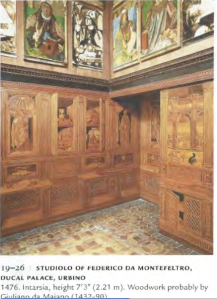 ( photo form pg642 0f the reading). Architecture also had its own personality in the Renaissance culture. The man who spread this around, thanks to his traveling, is Leon Battista Alberti(pg644 in the reading). This man decided to build a new church in 1472. Although he died to construction went on. He designed the building in mind with the Christian influence on the Renaissance, designing the floor plan to be in the shape of a cross. It was called the Church of Sant’Andrea(pg645 of the reading). These are some photos of the finished church:
( photo form pg642 0f the reading). Architecture also had its own personality in the Renaissance culture. The man who spread this around, thanks to his traveling, is Leon Battista Alberti(pg644 in the reading). This man decided to build a new church in 1472. Although he died to construction went on. He designed the building in mind with the Christian influence on the Renaissance, designing the floor plan to be in the shape of a cross. It was called the Church of Sant’Andrea(pg645 of the reading). These are some photos of the finished church: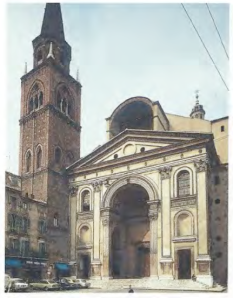
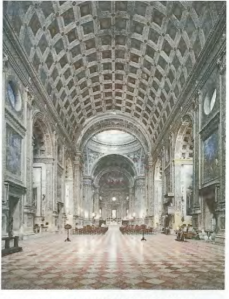
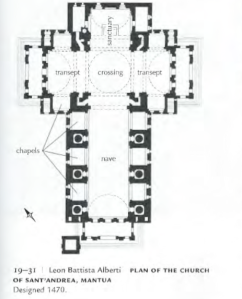 (all photos from pg.645) Also the elements of design also start to appear during the Renaissance such as contrast and gradation. You can see this in this painting by Perugino:
(all photos from pg.645) Also the elements of design also start to appear during the Renaissance such as contrast and gradation. You can see this in this painting by Perugino: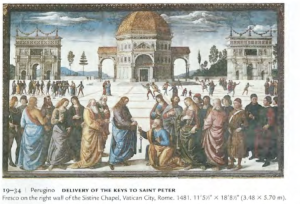 (pg 648) During the later Renaissance years the more naturalistic take on art has started to soften back into the Greek and Roman ideal of art and human, although keeping to Christian concepts into play. An example of this is The Birth of Venus by Sandro Botticelli done in th 1484-86:
(pg 648) During the later Renaissance years the more naturalistic take on art has started to soften back into the Greek and Roman ideal of art and human, although keeping to Christian concepts into play. An example of this is The Birth of Venus by Sandro Botticelli done in th 1484-86: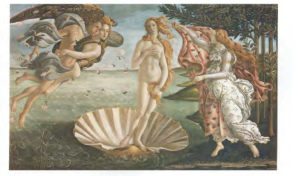 (pg651 of the reading). It is my personal opinion but this painting is one of the staple pieces of art from the Renaissance era. When I think of Renaissance art I usually think of this painting.
(pg651 of the reading). It is my personal opinion but this painting is one of the staple pieces of art from the Renaissance era. When I think of Renaissance art I usually think of this painting.
octopusgarden717







Very nice presentation.